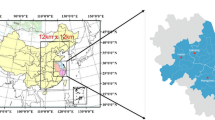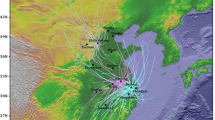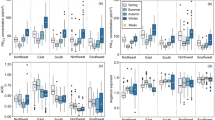Abstract
Monitoring of particulate matter (PM) is important in air quality, public health, and epidemiological studies and in decision-making for policy implementation. In the present study, the temporal variability of surface-measured PM concentrations ([PM]) and their relationship with meteorological variables and aerosol optical depth (AOD), with the aid from source apportionment studies, are investigated at four urban cities in the Chinese Yangtze River Delta (YRD) region during January 2014 to December 2017. The annual mean concentrations of [PM2.5] ([PM10]) observed at Shanghai (SH), Nanjing (NJ), Hangzhou (HZ), and Hefei (HF) were 46.98 ± 12.21, 54.84 ± 46.14, 52.82 ± 16.98, and 64.03 ± 20.57 μg m−3 (68.07 ± 14.33, 96.48 ± 26.86, 83.08 ± 22.38, and 97.61 ± 20.19 μg m−3), respectively. However, the [PM] exceeded the Chinese National Air Quality Standards of GB3095-2012, being higher (lower) during winter (summer). The [PM] was found higher in the morning (08:00–10:00 LT) and evening (18:00–20:00 LT) and lower in early morning (04:00 LT) and afternoon (14:00 LT) attributed to the dynamics of boundary layer height and varied emission sources. With an annual mean of 0.6–0.7, the PM ratio (PMr = PM2.5/PM10) was observed to have a single peak distribution in all seasons indicating the dominance of fine particles (PM2.5). Further, the [PM10] and [PM2.5] were highly correlated (r ≥ 0.90) in all cities, with slope > 0.70 representing the abundance of fine particles, except for NJ (< 0.70). A low correlation (< 0.5) was noticed between [PM10] and AOD550 suggesting that the aerosol particles had a large influence on AOD, contributing less to PM10. Finally, the concentration bivariate probability function (CBPF) and trajectory statistical models like potential source contribution function (PSCF) and concentration-weighted trajectory (CWT) suggested that local and regional sources contributed a lot for the high [PM2.5] observed at the four cities in the YRD, China.










Similar content being viewed by others
References
Apte JS, Marshall JD, Cohen AJ, Brauer M (2015) Addressing global mortality from ambient PM2.5. Environ Sci Technol 49:8057–8066
Balakrishnaiah G, Kumar KR, Reddy BSK, Gopal KR, Reddy RR et al (2011) Characterization of PM1, PM10 and PM2.5 mass concentrations at a tropical semi-arid station in Anantapur, India. Indian J Radio Space Phys 40:95–104
Balakrishnaiah G, Kumar KR, Reddy BSK, Gopal KR, Reddy RR, Reddy LSS, Swamulu C, Ahammed YN, Narasimhulu K, Moorthy KK, Babu SS (2012) Spatio-temporal variations in aerosol optical and cloud parameters over Southern India retrieved from MODIS satellite data. Atmos Environ 47:435–445
Boiyo R, Kumar KR, Zhao T (2018) Spatial variations and trends in AOD climatology over East Africa during 2002–2016: a comparative study using three satellite data sets. Int J Climatol 38:e1221–e1240. https://doi.org/10.1002/joc.5446
Carslaw DC, Ropkins K (2012) Openair—an R package for air quality data analysis. Environ Model Softw 27-28:52–61
Chen J, Xin J, An J, Wang Y, Liu Z, Chao N, Meng Z (2014) Observation of aerosol optical properties and particulate pollution at background station in the Pearl River Delta region. Atmos Res 143:216–227
Chen G, Morawska L, Zhang W, Li S, Cao W, Ren H, Wang B, Wang H, Knibbs LD, Williams G, Guo J, Guo Y (2018) Spatiotemporal variation of PM1 pollution in China. Atmos Environ 178:198–205
Chen P, Kang S, Yang J, Pu T, Li C, Guo J, Tripathee L (2019) Spatial and temporal variations of gaseous and particulate pollutants in six sites in Tibet, China during 2016-2017. Aerosol Air Qual Res 19:516–527
Cheng Z, Wang SX, Jiang JK, Fu QY, Chen CH, Xu BY et al (2013) Long-term trend of haze pollution and impact of particulate matter in the Yangtze River Delta, China. Environ Pollut 82:101–110
Deng J, Wang T, Jiang Z, et al (2012) Characterization of visibility and its affecting factors over Nanjing, China. Atmos Res 101:681–691
Draxler RR, Hess GD (1997) Description of the Hysplit_4 modeling system. In: NOAA Tech. Memo. ERL ARL 224, Air Resources Laboratory, Silver Spring, Md., Available at http://www.arl.noaa.gov/documents/reports/arl-224.pdf
Fontes T, Li P, Barros N, Zhao P (2017) Trends of PM2.5 concentrations in China: a long-term approach. J Environ Manag 196:719–732
He Q, Zhang M, Huang B (2016) Spatio-temporal variation and impact factors analysis of satellite-based aerosol optical depth over China from 2002 to 2015. Atmospheric Environment 129:79–90. https://doi.org/10.1016/j.atmosenv.2016.01.002
Hou X, Zhu B, Kumar KR, Lu W (2019) Inter-annual variability in fine particulate matter pollution over China during 2013-2018: role of meteorology. Atmos Environ 214:116842
Hsu NC, Tsay S-C, King MD, Herman JR (2004) Aerosol properties over bright-reflecting source regions. IEEE Transactions on Geoscience and Remote Sensing 42(3):557–569. https://doi.org/10.1109/TGRS.2004.824067
Hua Y, Cheng Z, Wang S, Jiang J, Chen D, Cai S, … Yu J (2015) Characteristics and source apportionment of PM 2.5 during a fall heavy haze episode in the Yangtze River Delta of China. Atmospheric Environment 123:380–391. https://doi.org/10.1016/j.atmosenv.2015.03.046
Kang N, Kumar KR, Hu K, Yu X, Yin Y (2016) Long-term (2002–2014) evolution and trend in collection 5.1 level-2 aerosol products derived from the MODIS and MISR sensors over the Chinese Yangtze River Delta. Atmos Res 181:29–43
Koelemeijer R, Homan CD, Matthijsen J (2006) Comparison of spatial and temporal variations of aerosol optical thickness and particulate matter over Europe. Atmos Environ 40:5304–5315
Kong L, Xin J, Zhang W, Wang Y (2016) The empirical correlations between PM2.5, PM10, and AOD in the Beijing metropolitan region and the PM2.5, PM10 distributions retrieved by MODIS. Environ Pollut 216:350–360
Kumar KR, Kang N, Yin Y (2018) Classification of key aerosol types and their frequency distributions based on satellite remote sensing data at an industrially polluted city in the Yangtze River Delta, China. Int J Climatol 38:320–336
Levy H, Horowitz LW, Schwarzkopf MD, Ming Y, Golaz J‐C, Naik V, Ramaswamy V (2013) The roles of aerosol direct and indirect effects in past and future climate change. J Geophys Res Atmos. 118:4521–4532. https://doi.org/10.1002/jgrd.50192
Li X, Ma Y, Wang Y, Liu N, Hong Y (2017) Temporal and spatial analyses of particulate matter (PM2.5 and PM10) and its relationship with meteorological parameters over an urban city in northeast China. Atmos Res 198:185–193
Li J, Liao H, Hu J, Li N (2019) Severe particulate pollution days in China during 2013-2018 and the associated typical weather patterns in Beijing-Tianjin-Hebei and the Yangtze River Delta regions. Environ Pollut 248:74–81
Liu Q, Wang S, Zhang W, Li J, Dong G (2018a) The effect of natural and anthropogenic factors on PM2.5: empirical evidence from Chinese cities with different income levels. Sci Total Environ 653:157–167
Liu Z, Gao W, Yu Y, Hu B, Xin J, Sun Y, Wang L, Wang G, Bi X, Zhang G, Xu H, Cong Z, He J, Xu J, Wang Y (2018b) Characteristics of PM2.5 mass concentrations and chemical species in urban and background areas of China: emerging results from the CARE-China network. Atmos Chem Phys 18:8849–8871
Mahapatra PS, Sinha PS, Boopathy R, Das T, Mohanty S, Sahu SC, Gurhar BR (2018) Seasonal progression of atmospheric particulate matter over an urban coastal region in peninsular India: role of local meteorology and long-range transport. Atmos Res 199:145–158
Mateos D, Cachorro VE, Toledano C, Burgos MA, Bennouna Y, Torres B, Fuertes D et al (2015) Columnar and surface aerosol load over the Iberian Peninsula establishing annual cycles, trends, and relationships in five geographical sectors. Sci Total Environ 518-519:378–392
Mukherjee A, Agrawal M (2018) Assessment of local and distant sources of urban PM2.5 in middle Indo-Gangetic Plain of India using statistical modeling. Atmos Res 213:275–287
Pikridas M, Vrekoussis M, Sciare J, Kleanthous S, Vasiliadou E, Kizas C, Savvides C, Mihalopoulos N (2018) Spatial and temporal (short and long-term) variability of submicron, fine and sub-10 μm particulate matter (PM1, PM2.5, PM10) in Cyprus. Atmos Environ 191:79–93
Segura S, Estelles V, Utrillas MP, Martinez-Lozano JA (2017) Long term analysis of the columnar and surface aerosol relationship at an urban European coastal site. Atmos Environ 167:309–322
Shao P, Xin J, An J, Kong L, Wang B, Wang J, Wang Y, Wu D (2017) The empirical relationship between PM2.5 and AOD in Nanjing of the Yangtze River Delta. Atmos Pollut Res 8:233–243
Shu L, Xie M, Gao D, Wang TJ, Fang DX, Liu Q, Huang AN, Peng LW (2017) Regional severe particle pollution and its association with synoptic weather patterns in the Yangtze River Delta region, China. Atmos Chem Phys 12871–12891
Song Z, Fu D, Zhang X, Wu Y, Xia X, He J, Han X, Zhang R, Che H (2018) Diurnal and seasonal variability of PM2.5 and AOD in North China Plain: comparison of MERRA-2 products and ground measurements. Atmos Environ 191:70–78
Sumesh RK, Rajeevan K, Resmi EA, Unnikrishnan CK (2017) Particulate matter concentrations in the southern tip of India: temporal variations, meteorological influences, and source identification. Earth Syst Environ 13:1–18
Tao J, Gao J, Zhang L, Zhang R, Che H, Zhang Z, Lin Z, Jing J, Cao J, Hsu SC (2014) PM2.5 pollution in a megacity of southwest China: source apportionment and implication. Atmos Chem Phys 14:8679–8699
Tian J, Chen DM (2010) A semi-empirical model for predicting hourly ground-level fine particulate matter (PM2.5) concentration in southern Ontario from satellite remote sensing and ground-based meteorological measurements. Remote Sens Environ 114:221–229
Tiwari S, Hopke PK, Pipal AS, Srivastava AK, Bisht DS, Tiwari S, Singh AK, Soni VK, Attri SD (2015) Intra-urban variability of particulate matter (PM2.5 and PM10) and its relationship with optical properties of aerosols over Delhi, India. Atmos Res 166:223–232
Wang YQ, Zhang XY, Draxler RR (2009) TrajStat: GIS-based software that uses various trajectory statistical analysis methods to identify potential sources from long-term air pollution measurement data. Environ Model Softw 24:938–939
Wang YG, Ying Q, Hu JL, Zhang HL (2014a) Spatial and temporal variations of six criteria air pollutants in 31 provincial capital cities in China during 2013-2014. Environ Int 73:413–422
Wang Z, Chen L, Tao J, Liu Y, Hu X, Tao M (2014b) An empirical method of RH correction for satellite estimation of ground-level PM concentrations. Atmos Environ 95:71–81
Wang J, Zhao B, Wang S, Yang F, Xing J, Morawska L, Ding A, Kulmala M et al (2017) Particulate matter pollution over China and the effects of control policies. Sci Total Environ 584-585:426–447
Wang Q, Jiang N, Yin S, Li X, Yu F, Guo Y, Zhang R (2018a) Carbonaceous species in PM2.5 and PM10 in urban area of Zhengzhou in China: seasonal variations and source apportionment. Atmos Res 191:1–11
Wang W, Yu J, Cui Y, He J, Xue P, Cao W, Ying H, Gao W, Yan Y, Xin Y, Hu B, Xin J, Wang L, Liu Z, Sun Y, Ji D, Wang Y (2018b) Characteristics of fine particulate matter and its sources in an industrialized coastal city, Ningbo, Yangtze River Delta, China. Atmos Res 203:105–117
Xia X, Li Z, Holben B, Wang P, Eck T, Chen H, Cribb M, Zhao Y ( 2007) Aerosol optical properties and radiative effects in the Yangtze Delta region of China. J Geophys Res 112:D22S12. https://doi.org/10.1029/2007JD008859
Yan D, Lei Y, Shi Y, Zhu Q, Li L, Zhang Z (2018) Evolution of the spatiotemporal pattern of PM2.5 concentrations in China—a case study from the Beijing-Tianjin-Hebei region. Atmos Environ 183:225–233
Yang Q, Yuan Q, Li T, Shen H, Zhang L (2017) The relationships between PM2.5 and meteorological factors in China: seasonal and regional variations. Int J Environ Res Public Health 14:1510–1528
Yang Q, Yuan Q, Yue L, Li T, Shen H, Zhang L (2018) The relationships between PM2.5 and AOD in China: about and behind spatiotemporal variations. Environ Pollut 248:526–535
Zhang YL, Cao F (2015) Fine particulate matter (PM2.5) in China at a city level. Sci Rep 5:14884. https://doi.org/10.1038/srep14884
Zhao SP, Yu Y, Yin DY, Qin DH, He JJ, Dong LX (2018) Spatial patterns and temporal variations of six criteria air pollutants during 2015-2017 in the city clusters of Sichuan Basin, China. Sci Total Environ 624:540–557
Zhou G, Xu J, Gao W, Gu W, Mao Z, Cui L (2018) Characteristics of PM1 over Shanghai, relationships with precursor and meteorological variables and impacts on visibility. Atmos Environ 184:224–232
Acknowledgments
We acknowledge the Ministry of Environmental Protection of China (http://113.108.142.147:20,035/emcpublish/) and China air quality online monitoring and analysis platform (https://www.aqistudy.cn/) for providing PM2.5 and PM10 data and NASA (https://modis-atmos.gsfc.nasa.gov/) for providing the MODIS AOD data. The boundary layer height and meteorological data derived from the ECMWF and MICAPS can be downloaded at https://www.ecmwf.int/ and http://www.cru.uea.ac.uk/, respectively. One of the authors Dr. KRK would like to thank the Department of Science and Technology (DST), Govt. of India for the award of DST-FIST Level-1 (SR/FST/PS-1/2018/35) scheme to Dept of Physics, KLEF.The authors would like to acknowledge Dr. Constantini Samara, the editor of the journal, and the two anonymous reviewers for their constructive comments and valuable suggestions toward the improvement of an earlier version of the manuscript.
Funding
This research has been financially supported by the National Natural Science Foundation of China (Grant nos. 41830965, 91644223, 91744209, 91644224) and the National Key Research and Development Program Pilot Projects of China (Grant no. 2016YFC0203304).
Author information
Authors and Affiliations
Corresponding authors
Ethics declarations
Conflict of interest
The authors declare that they have no conflict of interest.
Additional information
Responsible editor: Constantini Samara
Publisher’s note
Springer Nature remains neutral with regard to jurisdictional claims in published maps and institutional affiliations.
Electronic supplementary material
ESM 1
(DOCX 5987 kb)
Rights and permissions
About this article
Cite this article
Ding, H., Kumar, K.R., Boiyo, R. et al. The relationships between surface-column aerosol concentrations and meteorological factors observed at major cities in the Yangtze River Delta, China. Environ Sci Pollut Res 26, 36568–36588 (2019). https://doi.org/10.1007/s11356-019-06730-6
Received:
Accepted:
Published:
Issue Date:
DOI: https://doi.org/10.1007/s11356-019-06730-6




